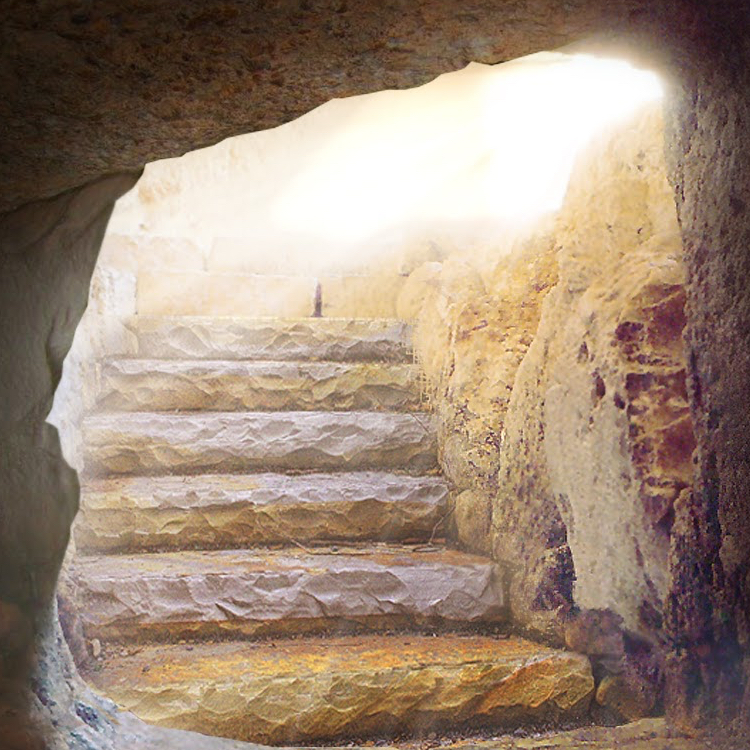Come to think of it, to illustrate in fitting fashion the most earthshaking event in the history of humankind ever, the Church should have picked an Easter gospel passage that conveyed clearly and unequivocally the Resurrection of Jesus from the dead. Instead, we have John’s account (20:1-9) of an empty tomb and of the shroud collapsed in place where the lifeless body of Jesus was laid and the sudarium (literally a sweat cloth, a towel) rolled up in the oval shape around where the bruised head of Jesus should have been.
This we are given along with dissimilar conclusions reached by three different people who loved Jesus most sincerely, most deeply. Every year at this time, we celebrate THE event that, for believers, connects the fleeting phenomenon of time with the endless duration of eternity.
This time, perhaps, it would be most profitable for us to find the correct way to reinterpret our temporary sojourn on this earth in light of the Resurrection by considering it as the single event that can fill us with hope, with confidence, with resolve and singular courage. Obviously, looking at this event after a span of 2000 years, we cannot relive the same tomb setting with the deflated swats that wrapped the body of Jesus; we cannot examine the sudarium (towel) that enclosed the head of our Savior.
We ought to rely on the reaction of Mary Magdalene, Simon Peter and the other disciple, the one whom Jesus loved.
I submit to you that the rest of our time spent on this earth will acquire a whole new meaning and be filled with unparalleled inner energy if, over time, we let ourselves soak in the Resurrection the way they did.
As the second verse indicates, (we do not know where they have laid him) Mary Magdalene did not go alone to the tomb in which the corpse of Jesus was supposed to be. However, she is singled out because of the intensity of her love for Jesus. The Lord had already cast out seven demons from her (see Luke 8:2) and set her on the right path to discipleship. Hence, although she does not know, her love has placed her in the right receptive disposition to see and to believe. If we read on, we find out that the Risen Lord, the Good Shepherd will appear to her first; will call out her name “Mary” and, she, one of his loyal sheep, will recognize his voice and become the first messenger sent to announce the Resurrection to the other “messengers to be sent” (apostles).
As it is for these three disciples, for us too, the relevance of the Resurrection is felt around losses and pain. Mary Magdalene shows us how intense and passionate love for Jesus will pay enormous dividends and show us how to endure the nearly unendurable.
Speaking of love: undoubtedly, Simon Peter too has love for Jesus. But his love is “bruised love.” It has been marred by repeated failures and is stifled by the nagging recollection of his cowardly, threefold denial of Jesus. Before the disappearance of the corpse of his Master he remains puzzled and confused. The Risen Lord will appear to him in private; and by the shore of the lake of Tiberias, he will give him a moving and comforting chance to reaffirm all his love.
Perhaps, the Risen Lord wanted more; but he has to settle for Peter’s mere human, imperfect love. Three times, (as many times as he had denied knowing his Master) Simon Peter will confess his total love for Jesus. Hence, three times, in the incredible empowerment bestowed by the Resurrection, the Risen Lord will give Simon Peter the lofty task of feeding all the sheep in his absence.
Hopefully, quite a few of us might notice how the Resurrection is affecting their life in all its many facets through the daily purification from human imperfections as Jesus did with Mary Magdalene. Undoubtedly, others might see themselves as sought out, recovered, given multiple chances and reconfirmed in their imperfect love for Jesus the way Simon Peter was even if the love of which they are capable is still very imperfect.
If our love for Jesus is still a “work in progress” but we are sincere and willing to cooperate with God’s grace, Simon Peter is our representative. Now, logically, I should say that some are like the disciple whom Jesus loved. But that is not possible.
More accurately, it would be possible if any of us had cooperated with God’s grace and not wasted a single opportunity to capitalize on the constant help we receive from above. Notice how this third disciple remains unidentified: he/she is the ideal disciple. He/she remains the perfect replica of the Lord himself. Now, whether we identify with Mary Magdalene or with Simon Peter, the Lord wishes us to strive to become like the disciple whom he loves above the rest.
So, what does the ideal disciple do?
- He sees: he capitalizes on the vision provided by God’s Holy Scripture and God’s insights to see with the eyes of faith way beyond what strikes our physical senses. In the heights of elation, in the throes of tribulation and in the flatness of ordinariness, the disciple whom Jesus loves sees an uninterrupted chain of messages.
- They repeat the messages strewn carefully and insistently, from cover to cover, through the pages of Holy Scripture: “I love you,” “Fear not,” I am with you always.”
- He/she believes based on flimsy evidence that would go, most likely, unnoticed. Where Simon sees the swaths and the sudarium that had wrapped the mauled body of Jesus and concludes that, most likely, the corpse was stolen by the enemies, the ideal disciple sees that a Power from within ordinary bandages had freed the Lord from the throes of death itself.
- The ideal disciple sees the difference between Lazarus’ resuscitation (he had to be freed of his burial bands by friends and relatives) [see John 11:44] and the uncontainable, self-triggered explosiveness of the Resurrection.
- Because of his ability to see beyond what ordinary sight allows, the disciple whom Jesus loves believes.
I am convinced that our loving Father inspired His Church in a singular way to write this narrative about the empty tomb for a specific purpose. The purpose is to elicit a faith that would enable us to remain firm in our trust in spite of unforeseeable, trying circumstances. The purpose is to elicit unshakeable faith no matter what.
The faith of the ideal disciple of Christ is, of course, as always, a gift from God, yet it is a gift that should be nurtured by loyalty born of ordinary, daily, repeated closeness to the beloved until one’s love enters a new, heavenly dimension. Perhaps a reoccurring example of this faith nurtured by loyal love is the one of a mother who remains convinced of the innocence of her son in spite of mounting evidence to the contrary.
Hence, here is an invitation to all of us: if we truly desire to make the Resurrection of Christ the event that will see us through the most harrowing trials that life might throw at us, we should learn to decipher the little messages of love that the Risen Lord sends us around the clock. They might go unnoticed to most people around us. For a while, they might be missed by us, too. But, eventually, if we keep asking the Lord for seeing the way an ideal disciple should, we will see them and our loyalty for him will blossom and sustain us through thick and thin until the time will come to share for good in his Resurrection.








